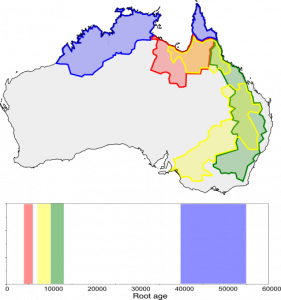Proposals for the origin of Pama-Nyungan include homelands that span the length and breadth of the continent, time scales ranging from ~4,000 years ago to more than 40,000 years ago and a range of different possible mechanisms of expansion. We tested between four competing theories. The figure below shows the root age and homeland implied under each scenario.

Hypothesis 1: in red, assumes an origin south of the Gulf of Carpentaria, and an age of 4 to 6kya.
The expansion is linked in the literature to one or more of technological advantages (e.g. backed artefacts), ceremonial advantage or, for later stages of the expansion, the dingo. That is, the mechanism of expansion is primarily cultural.
Hypothesis 2: in yellow, assumes an origin from late Pleistocene refugia in the Eastern Gulf Plains, Einasleigh Uplands, Brigalow Belt South, and Murray Darling Depression at 7 to 9kya.
It is based on an assumed expansion during the Holocene Climatic Optimum; with further fragmentation following an ENSO-onset. That is, the trigger of expansion is primarily a response to climate change.
Hypothesis 3: in green, assumes an origin in the Great Dividing Range, at 10 to 13kya.
It is motivated by a Pama-Nyungan expansion from refugia after the Antarctic Cold Reversal following a `bottleneck’ during the last glacial maximum. Again, under this hypothesis, the trigger for expansion is climatic.
Hypothesis 4: in blue, assumes an old origin 40 to 55kya with the entrance of the first people from the north. It assumes an expansion into uninhabited territory from original colonisers, with subsequent ongoing local expansion and diffusion.
